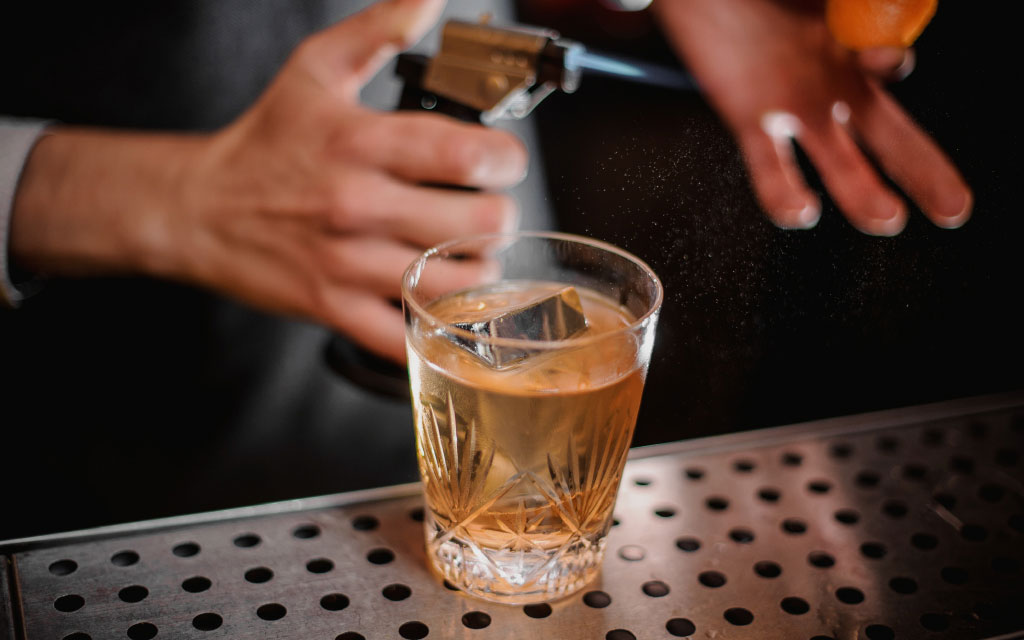
For most of us, just hearing the words “smoked” or “smoky” in combination with any list of cocktails will instantly conjure memories of that scent we first encountered when a bartender revealed some majestic concoction through a plume of smoke as it rose above the bar top.
This article covers a lot, so here’s what I’m going to talk about. Feel free to skip ahead!

Smoked vs Smoky Cocktails
Before we get too far, I’d like to clarify a key distinction. There are two ways to get a cocktail to taste or smell smoky. The most common one is to use smokey tasting ingredients. The other is to “smoke” the cocktail itself.
As previously mentioned, using smoke-infused ingredients as well as smoked spirits themselves is nothing new to the world of cocktails. Two of the most famous examples that come to mind are Scotch whisky and mezcal.
Though both boast bold, rich smoke flavors, the process by which the smoke is infused into the spirits differs wildly. Even the ingredients being burned to create the smoke, as well as those being infused with the smoke, are vastly different. But I digress… We will save that discussion for another time and focus on the “smoky cocktails” specifically.
However, before we go forward, it’s good to keep in mind that both heavily-peated Scotch whisky and mezcal can be a great substitution when you still want to add that smoked essence to your cocktail, but it is impractical to use real smoke or set a small fire inside your home or place of work (because some people may frown upon this… my bad). Moving on!
Smoked spirits and flavorings aside, let’s get down to the nitty-gritty of how to actually smoke a cocktail. There are many different ways to go about applying smoke to a cocktail, and every bartender will have his or her own method and process that they have perfected to create their finest smoked cocktail.

Is Smoking Cocktails a New Thing?
It may be easy to imagine that this type of cocktail craftsmanship was born long ago, possibly in some wood-adorned, dimly-lit, prohibition-era speakeasy where cigar smoke filled the air and every other booth held a personality even shadier than their respective dark corners.
However, with a little bit of research, you might find that that idea goes up in smoke (yeah, I went there). In fact, although flaming citrus zests and playing with fire have been documented since the mid-19th century, to find some of the first examples of smoking a cocktail in the glass, we’ll have to shoot forward in time about 80 years, to 2007, when Eben Freeman was smoking up cocktails in New York City.
That’s right! Although smoked ingredients and the act of infusing the flavor of smoke into cocktails has been around for centuries, the art of actually “smoking” a cocktail or the cocktail glass itself is somewhat of a new trend. So let’s discuss this new-found affinity for the elegant, ashy but mostly divisive movement of the smoked cocktail, as well as some modern methods to smoking a cocktail.

How to Make a Smoked Cocktail
The following methods are those most commonly used to smoke cocktails today, but these aren’t your only two options, of course.
Method 1: The Smoking Gun
First, we will consider the smoking gun. For many restaurants and bars, the smoking gun has become a popular option for the speed and consistency at which they smoke.
Here’s how they work:
- A small “smoking chamber” is filled with an assortment of wood chips (some examples include Applewood, Cherrywood, Hickory, Oak, Mesquite and Maple).
- After the wood chips are prepped, the cocktail is then made and usually placed inside some sort of chamber (often made of glass to keep the smoke from escaping).
- The fans within the gun are turned on by using a small chef’s torch to ignite the wood chips and switching the gun on; this pumps the smoke through a tube into the chamber containing the cocktail.
- The cocktail stays in the chamber for a minute or two to let the smoked flavors and spices fill the glass and envelope the drink.
- Once the cocktail is well-smoked, remove the chamber and, with a billow of beautiful smoke, a freshly smoked cocktail is ready to be imbibed.
Should you use a smoking gun?
Here are some pros and cons for using a smoking gun to smoke cocktails:
Pros:
- They are relatively compact and easy to use.
- A smoking gun is less risky than an open flame in a bar.
- There are a variety of options, from entry-level to professional at price points that will meet every budget.
Cons:
- The flavor in your smoky cocktail can be weaker using this method; however, you can maximize the smoke in your cocktail by using a smaller vessel.
- This requires an extra piece of equipment… which may be a “pro” for some!

Method 2: Using a Wood plank for Smoking Cocktails
Another common way to smoke a cocktail (and my preferred method) involves a wood plank or wood board as the smoking surface. Oak is commonly used, yet here lies an opportunity to use any number of unique woods to create new flavor combinations. (Just be sure these are fresh, untreated woods without any lacquer or chemical coatings.)
First, prepare your glass:
- To begin smoking a cocktail on a wood plank, you will first place a small, palm-sized pile of wood chips near the center of your plank, making sure that they are placed in a tight enough bunch that the lip of your glass can fully encompass them.
- Next, using your torch, begin heating the wood chips in an even, circular motion. Without trying to fully ignite the wood chips, continuously move the flame around the chips to create a small smoulder within the pile. *NOTE: If flames do appear, gently blow them out.
- Once a decent amount of smoke has accumulated, place the glass upside-down over the top of the smouldering chips, letting the smoke build up within the glass.
Build Your Smoked Cocktail
While the smoke accumulates inside the glass, now is when I would recommend you begin building the cocktail within a mixing glass. (For this example, I will be making an imaginary Old Fashioned for simplicity’s sake.)
- Once all of the ingredients for your Old Fashioned (*wink*) are measured and poured into the mixing glass (but before ice or stirring!), take a cocktail napkin and place it in the palm of your hand.
- Then place a large ice cube on top of that.
- Semi-quickly, and without upturning the glass we’ve been smoking, place the glass (with smoke still trapped underneath) over the large ice cube and napkin, making sure the napkin has created a full seal around the lip of the glass, allowing no smoke to escape.
- Flip over the glass with your hand and the napkin still on top, keeping the smoke and ice within the glass, which allows the smoke to penetrate the pores of the ice.
- Now, while your large ice cube steeps in smoke, you can begin stirring the cocktail. So add ice, and stir!
- Once your cocktail is fully mixed (approx. 20% dilution… depending on who you ask), you are ready to pour! Remove the napkin from atop the glass, allowing some smoke to escape, and slowly pour the Old Fashioned from the mixing glass over the large ice cube within the glass. (This will push out any remaining smoke, creating a cool waterfall effect around the glass).
- Finish the cocktail with your orange peel or lemon twist & cocktail cherry, and that’s it.
You now have a smoked cocktail (in this case, the trusted Old Fashioned), presentable to any guest!
Should you use the wood plank method?
Here are some pros and cons for using the “plank of wood” technique to smoke cocktails:
Pros:
- This is an effective method that provides great smoked flavor in your cocktail.
- It definitely catches your guests’ attention!
- There are a variety of small, inexpensive chef’s torches that won’t break the bank.
Cons:
- This technique requires a bit more practice to get it right
- C and can be a little riskier, safety-wise.
Tips, Tricks, & Techniques for Cocktails with Smoke
Having trouble getting that smoky flavor? Here are a few additional tips.
Smoke will not adhere to a dry glass. Although the smoke may settle in the glass for a few moments, once it has dissipated into the air, it will be gone or barely noticeable within the drink. Smoke needs something to adhere to within the glass.
One way of dealing with this issue is to rinse the glass with a liquid, whether with your cocktail’s base alcohol or perhaps another ingredient you would like to highlight.
Smoking the entire cocktail as a whole once it’s already been made is another way to ensure that the smoked flavor will stick to the drink. Just remember: If you smoke a completed cocktail too long, you run the risk of over-diluting the cocktail or letting it “die” (allowing the ice to melt too much, watering down the cocktail before the customer has even had a chance to drink it).
Even ice can be smoked for a short period of time, allowing the smoke to penetrate the small pores and cracks within the ice, giving the smoke an almost time-release effect as the ice melts into the cocktail.
Though the art of smoking a cocktail may be a somewhat newer trend in the world of bartending, it follows a long line of creative, innovative thinking and ingenuity that has kept the art and occupation of bartending alive and well (even when alcohol was illegal for OVER A DECADE).
So as long as there are still patrons around to enjoy cocktails, there will always be bartenders, young and old, creating new and inventive ways to make your imbibing experience one-of-a-kind. And we have a ton of them in our Craft Cocktail Club, just waiting to share their creations with you. Always be safe, and be sure to tip your local bartender!



